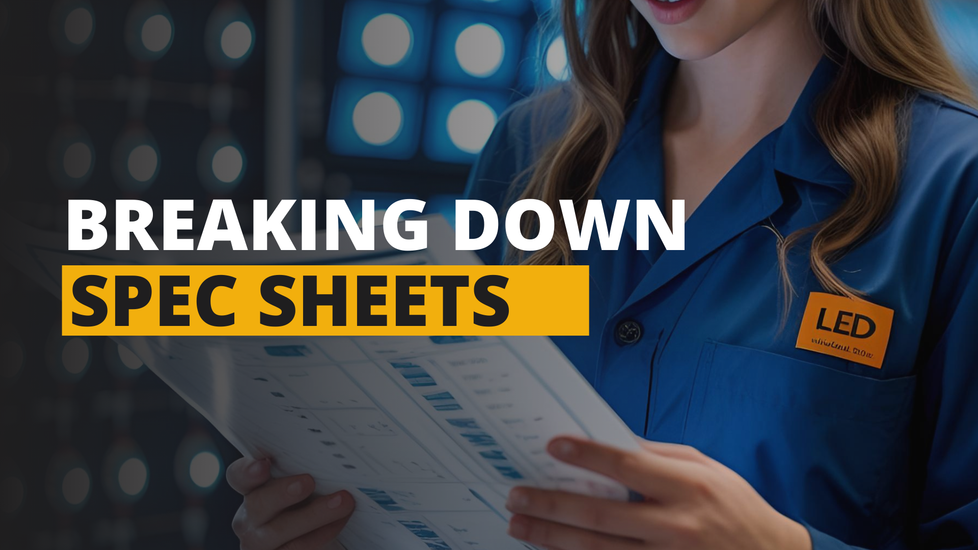Spec Sheets: An Engineer's Fast Guide to Product Data
Posted by Finn O'Connell, Senior Energy Systems Engineer, Big Shine LED on Jul 7th 2025
Okay, project people, let's talk spec sheets. For us engineers, these aren't just dry documents; they're the DNA of your product. I'm here to show you how to hack these things, what those numbers really mean, and why skipping this step is a fast track to project headaches. Think of it like this: your brain wants the facts, fast. Spec sheets deliver.
Why Bother with a Spec Sheet? (Beyond "Because You Have To")
Ever picked a part based on a picture, then wished you hadn't? That's why spec sheets exist. They prevent rework, budget overruns, and late-night "why isn't this fitting?!" moments. Knowing your product's true capabilities upfront saves future you from a massive headache. It's about being proactive, not reactive.
Deconstructing the Data: Key Variables & What They Tell You
Forget flowery language. Spec sheets give you hard data. Here's what I zero in on:
- Input Voltage/Power (e.g., 120-277V, 50W): This tells you if it'll even turn on with your existing electrical setup. Match this perfectly, or you're buying a very expensive paperweight. It also dictates energy consumption. Lower watts often mean lower bills.
- Lumens (e.g., 5000 lm): This is your brightness. More lumens mean more light output. Don't just look at watts; a high-efficiency product delivers more lumens per watt. This is key for achieving required light levels in your space.
- Color Temperature (CCT - e.g., 3000K, 5000K): Measured in Kelvin (K). This is the "color" of the light.
- 2700K-3000K: Warm, cozy, like incandescent bulbs. Good for homes, restaurants.
- 3500K-4000K: Neutral white. Good for offices, retail. Less yellow, not too blue.
- 5000K-6500K: Cool, crisp, like daylight. Best for workshops, warehouses, task lighting. Pick the right "mood" for your space.
- Color Rendering Index (CRI - e.g., >80, >90): How accurately colors appear under the light. Higher CRI means truer colors. For art galleries or retail, target CRI 90+. For a warehouse, CRI 70-80 might be fine.
- Beam Angle (e.g., 120°, 60°): How wide the light spreads. Smaller angles mean more focused light (think spotlight). Larger angles mean wider spread (think floodlight). Choose based on whether you want to highlight a specific area or illuminate a broad space.
- Rated Life (e.g., L70 @ 50,000 hours): This is crucial for longevity. L70 means the light output will degrade to 70% of its initial lumens after X hours. This is your replacement cycle predictor. Longer life means less maintenance hassle.
- Certifications (e.g., UL, DLC, Energy Star): These aren't just logos. They signal safety, quality, and energy efficiency. For incentives, DLC (DesignLights Consortium) is vital for commercial lighting. Energy Star is common for consumer products. UL means it meets safety standards. Don't skip these.
Test Results: The Proof in the Pudding
Sometimes, spec sheets include actual test data. This validates the manufacturer's claims. Look for:
- LM-79 (for LED luminaires): This report details total lumen output, power consumption, efficacy (lumens/watt), and color data (CCT, CRI). It's the official performance fingerprint.
- LM-80 (for LED packages/arrays): This focuses on lumen maintenance of the LED chip itself over time, which feeds into the L70 calculations for the finished product.
Understanding these reports confirms your product's performance will meet expectations, preventing costly surprises down the line.
Your Project, Optimized: Start with Smarter Choices
Don't just glance. Dig into those spec sheets. Knowing these variables lets you:
- Confirm compatibility: No more electrical mismatches.
- Optimize performance: Get the right light, brightness, and color for your space.
- Plan for longevity: Understand maintenance cycles and save on future costs.
- Secure incentives: Ensure your product qualifies for those energy rebates.
At BSW Partner Hub, we equip you with the right products and the knowledge to use them effectively. We're here to make your project successful, from the first line on a spec sheet to the final light flip.

